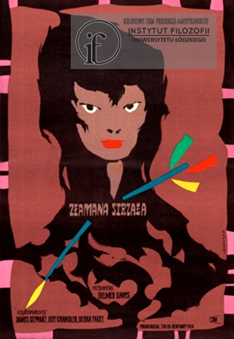
by Jędrzej Janicki (23.06.2020)
A Western made on a grand scale. The end of the golden age of Hollywood. A great world and a great movie (at least assumedly). All this reached Poland in 1957. And let no one try to tell us that a small seven-year delay can be any reason to complain...
"Broken Arrow" is a thoroughbred Western from 1950, directed by Delmer Daves (the creator known mainly from the surprisingly successful film "15:10 to Yuma"), which had its premiere in Poland in 1957. This Western, like the vast majority of Westerns, lacks an overly elaborate and demanding plot. Daves' story takes us to the Wild West around the middle of the 19th century. There are bloody and brutal feuds there between aggressive settlers and Indians defending their interests. A Captain played by James Stewart (a veteran of World War II and the Vietnam War, as well as the idol of American cinema of the 1940s and 1950s) is to reach an agreement with the chief of the local tribe (Oscar nomination for a supporting role for Jeff Chandler) to end mutual gruesome bloodshed. However, the agreement reached between the two gentlemen will not be fully respected by everyone...
The poster by Roman Cieślewicz makes a really big impression even at first glance. The foreground of the picture is mainly covered with a typically portrait representation of a mysterious person. The impenetrable black of her hair was beautifully contrasted with the blood red of her lips and the disturbing white of her eyes. An arrow, piercing the character's neck, was also shown in a very interesting way. With its cheerful colours, it refers rather to the peaceful symbol of the hippies than to the fixed image of the murder weapon. What is more, this arrow looks broken and wraps around the title of the film, which is a simple trick used by Cieślewicz so as to focus the viewer's attention on the very content of the work. It seems that this way of presenting the human face (in an ascetic manner) is close to Cieślewicz’s style - this is visible in his fascination with the painting of Mona Lisa (in the late 1960s Cieślewicz created a series of "transformations" of this famous Leonardo’s work[1]). The proportions of the character from the "Broken Arrow" poster and from the presented version of Mona Lisa are very similar to each other. The arrow from the poster corresponds to an irregular line of black paint running along the body of Mona Lisa - these two elements play the same role in structuring the composition in both of these works.The whole character from the "Broken Arrow" poster brings to my mind the image of Mira Kubasińska from the band Breakout, shown on the cover of the band's debut album "Na drugim brzegu tęczy "(On the Other Side of the Rainbow) (1969). I wonder if Małgorzata Spychalska was inspired by Cieślewicz's poster when she created the setting for this bigbeat gem...
One cannot walk passed this poster with indifference. It is an independent work that breaks away from the film's original. Those piercing eyes may lie, but they undoubtedly hypnotize and turn out to be a warning whenever there is even a hint of disloyalty whispering maliciously about breaking the agreement reached... Cieślewicz himself claimed that he would characterize his attitude towards the world as panic[2]. The world perceived with such high precision does indeed provide much evidence for such a view. I have the impression that the character from the "Broken Arrow poster" is also staring somewhere deep into reality with such a panic-stricken and penetrating gaze...
[1] One of the examples of these transformations: https://www.artnet.com/artists/roman-cieslewicz/mona-lisa-for-the-cover-of-opus-n-5-1Rqe_XUiyIwAhNhXeXNAaQ2
[2] Krzysztof Teodor Toeplitz, Paniczny, brzydki i źle wychowany (Panicked, ugly and ill-mannered), w: Roman Cieślewicz. Retrospektywa, Narodowa Galeria Sztuki Współczesnej Zachęta, Warszawa, 1994, s. 7.
